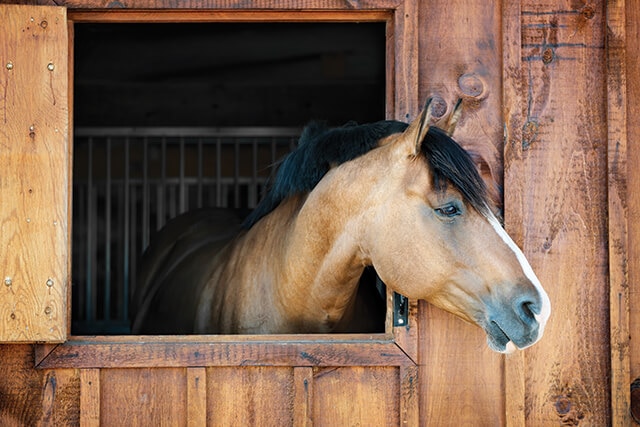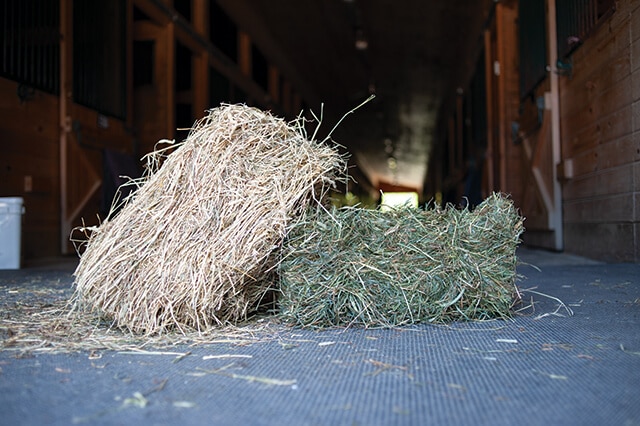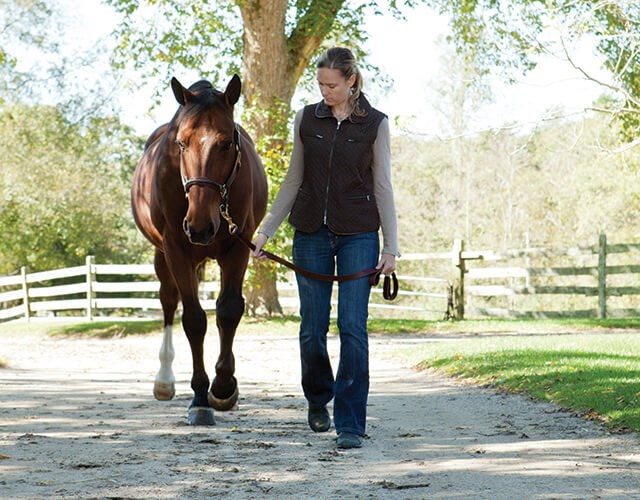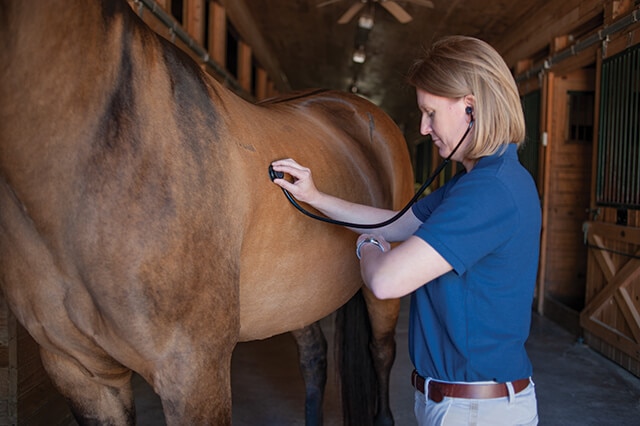Colic in Horses
Equine Colic & Digestive Health
What is Colic?

Colic is a general term that refers to abdominal pain in horses. While some cases may be so mild they might not even be noticed, colic can quickly become a medical and even surgical emergency. In fact, according to the 2015 National Animal Health Monitoring System (NAHMS) Study, colic is the leading cause of death in horses aged 1 to 20 years. That is why it is so important for anyone who owns or cares for horses to understand the risk factors and causes of colic, its signs and symptoms, the different types of medical and surgical colic in horses, when to call the veterinarian out to diagnose and treat the condition, and what you can do to try and prevent colic in horses.
Risk Factors and Causes of Colic

In most cases, the underlying cause of a colic episode is never determined. This is partly why myths and misconceptions abound such as the advice not to let a horse drink cold water after exercise, or not to let a horse roll if he’s showing signs of colic for fear that his intestines will twist. Fortunately, experts in the field have combed through the literature and identified some proven risk factors for colic in horses, many of which are preventable.
Hay Changes
Changes in hay, including switching types or feeding a new cut, can increase a horse’s chances of developing colic by 10x.
Grain Changes
Grain changes, including changes in amount, type or brand, can cause a 5x increase in colic risk.
Lack of Water
Lack of access to water has been associated with greater risk for GI trouble, including impaction colic.
Increased stall time
Research shows that stabling increases the chances of colic episode compared to being turned out.
Change in Activity
Sudden increases or decreases in the amount of exercise a horse gets can lead to digestive disturbance.
Deworming
Failure to receive appropriate deworming doubles a horse’s risk of developing colic.
History of Colic
Horses with a history of previous colic are at a four-fold higher risk for future colic episodes.
Other proven risk factors include feeding more than 5 pounds of grain in one meal, spending time in a stall vs being turned out, feeding hay from round bales, dramatic changes in exercise (either more or less), feeding coastal Bermudagrass hay, excessive use of non-steroidal anti-inflammatory drugs (NSAIDs) like “bute” and Banamine ® and being turned out on sand.
Signs and Symptoms of Colic
Early treatment of the colicky horse is key to a successful outcome. This means being able to quickly recognize the signs of colic in horses, including knowing how to take equine vital signs. Although some horses may demonstrate GI discomfort in their own unique way, the American Association of Equine Practitioners (AAEP) has developed a list of common signs and symptoms of colic in horses that every owner and caretaker should become familiar with:
- Pawing
- Looking at, kicking or biting the abdomen
- Stretching out as if to urinate
- Repeatedly lying down and getting up
- Rolling
- Sitting in a dog-like position or lying on the back
- Not eating or drinking
- Lack of bowel movements
- Absent or reduced digestive sounds
- Elevated respiration or heart rate
- Sweating
- Depression
- Lip curling (Flehman response)
If you see any signs of colic in your horse, remove all food, put him in a safe area, collect whatever vital signs you safely can, and call your vet. Information that will be especially helpful to your vet in determining if your horse needs to be seen right away includes the specific signs of colic that you’ve observed and their severity; temperature, pulse, and respiration; gum color, moistness, and refill; gut sounds, and any recent bowel movements.

Based on this info, your vet will determine if this is a simple case of “wait and see” or an emergency that needs to be looked at right away. Either way, you’ll receive specific instructions on what to do and what not to do while you’re waiting such as:
- hand walk? -- yes but not excessively
- feed? -- not hay or grain but possibly handfuls of grass or a few treats to check appetite
- allow to lie down and/or roll? -- yes if calm
- administer medication? -- only if specifically directed to do so
Types of Equine Colic
Since the word “colic” is just a term for abdominal pain in the horse, it does not refer to a specific location or cause of the discomfort. There can be many reasons for an uncomfortable abdomen, some of which are simple and can be treated medically and some of which are more complicated and require surgery. The AAEP has classified the different types of equine colic into three main groups:
- Intestinal Dysfunction
- Intestinal Accident
- Intestinal Inflammation or Ulceration
Intestinal Dysfunction iis the most common category and simply means that the horse’s bowels are not working properly. Types of colic that would be included under this heading include gas or spasmodic colic (the most common type of colic), impaction colic (such as by normal feedstuffs, bedding, or sand), and decreased motility, also known as ileus. While colic is always an emergency, the majority of cases in this category either resolve on their own or after just one medical treatment.
Intestinal Accidents occur less frequently but are more serious and may require surgical correction if medical treatment is unsuccessful. This group includes displacements, entrapments, and twists, and may involve a loss of blood supply to a section of bowel. Displacements are the movement of a bowel segment from its normal place and position to another. For example, in a right dorsal displacement, the right dorsal colon and cecum are moved or displaced from their normal location against the right body wall. Entrapments are when a section of bowel becomes caught in a tight space. One example is a nephrosplenic ligament entrapment, in which the left dorsal colon gets trapped between the left kidney, spleen, and nephrosplenic ligament. An intestinal twist is referred to as “volvulus” by veterinarians, and can occur in the small intestine or in the large intestine (colon).
Intestinal Inflammation or Ulceration is named according to the section of bowel that is involved, such as gastritis for stomach issues, enteritis for small intestinal issues, and colitis for large intestinal issues. These types of colic can be caused by numerous factors including stress, medications, infection, and parasites. Medical treatment (along with diet and management changes) is more appropriate in most cases than surgical intervention.
Diagnosis of Colic

Depending on how painful a horse is upon arrival, the vet may get right to work treating him or start by reviewing some facts with the owner or caregiver and then perform a physical examination. The handler should be prepared to provide an accurate history (including the feeding program, the horse’s usual exercise and turnout routine, deworming and vaccination programs, any recent travel or other change) and to share current observations. Then the vet will examine the horse, which may include rechecking all the vital signs, listening to gut sounds, performing a rectal palpation, passing a nasogastric (stomach) tube, collecting fluid from the abdominal cavity, drawing blood, and other diagnostic tests such as ultrasound or x-ray. This collection of information helps the vet come up with a list of possible causes for as well as types of colic, which is necessary for developing a treatment plan.
Colic Treatment
Based on the history and physical exam findings, the vet may start medical treatment on-site, refer the horse for medical treatment at a veterinary hospital, or refer the horse directly to surgery. It’s not always obvious when a colic can be resolved medically vs when surgery is required, but a horse with a high heart rate, pain that cannot be resolved with medication or that returns very quickly, or the actual palpation of a twist, entrapment, or displacement rectally are all indications that surgery may be necessary.
Since the most common cause of colic in the horse is gas or spasmodic colic, the majority of horses respond to basic medical treatment that may include a pain-reliever such as Banamine (flunixin meglumine), sedation, fluid therapy, or a laxative such as mineral oil. However, if any of the following occur:
- signs of complete or partial obstruction of the bowel
- persistent or severe abdominal pain
- the horse appears to be going into circulatory shock,
- a lack of response to medical treatment in general
Then the vet may suggest immediate referral to an equine hospital for further workup, additional medical treatment such as intravenous fluids, or emergency abdominal surgery.
Management suggestions & supplements that may lend support
Although the exact cause of colic is not known in the majority of cases, what is known is that certain feeding and management practices can increase a horse’s risk for colic. And while it is not possible to entirely prevent colic even with the best diet and care, the following advice may lessen a horse’s risk.
Diet and feeding
Make any changes to the diet gradually. This includes switching types or brands of grain as well as switching types, cuttings, or even batches of hay. Introducing horses to new or different pastures should also be done with care. When transitioning from one feedstuff to another, take at least 7 to 10 days to slowly blend the new in with the previous type to help ease the stress on your horse’s hindgut. Allow access to grass for just a few minutes more each day, working up to the full amount of turnout. This helps the beneficial bacteria in the digestive tract get accustomed to new feed sources. It can also be helpful when switching feeds to have a digestive support supplement on board that contains prebiotics, probiotics, or postbiotics; yeast; and enzymes to help ease the transition.
Stabling and activity
Because increased stall time is a risk factor for colic, keep horses turned out as much as possible. Since studies have shown that horses without access to grazing or those with a recent reduction in grazing time were three times more likely to colic than horses at pasture full time, turn out on grass pasture is best if this is appropriate for your horse. Research also suggests there is a higher risk of colic in horses that have a significant and sudden change in activity or exercise, so make increases and decreases to a horse’s workload (both duration and intensity), gradually.
Health and wellness care
Failure to receive appropriate deworming doubles a horse’s risk of developing colic. A sound parasite control program includes fecal egg counts, strategic use of dewormers, and proper manure management. Owners and barn managers should work closely with local veterinarians to develop the best deworming protocol for their individual horses and barns.
Additional proven risk factors for colic include lack of access to water, excessive use of NSAIDS, and the ingestion of sand. Take steps to lower the chances of a colic episode by ensuring that horses:
- always have access to clean, fresh water
- are on the lowest effective dose of non-steroidal anti-inflammatories for the shortest period of time as prescribed by the veterinarian, and
- have limited sand intake and are supplemented with psyllium to assist with fecal sand clearance
Additional Resources
From our site:
- Colic Prevention: Proven tips to reduce risk
- ColiCare: Colic Surgery Reimbursement Program from SmartPak
SmartPak strongly encourages you to consult your veterinarian regarding specific questions about your horse's health. This information is not intended to diagnose or treat any disease, and is purely educational.